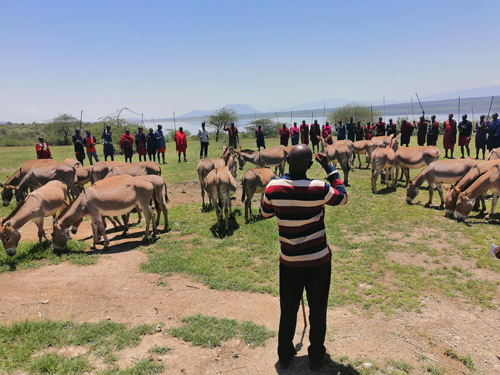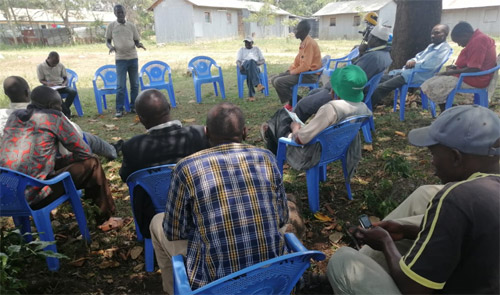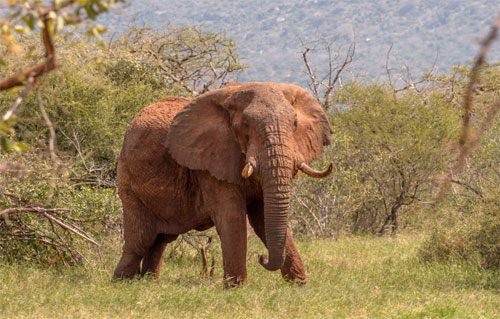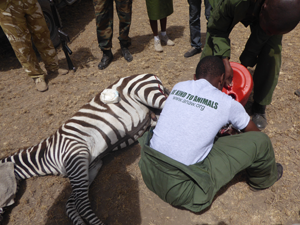Animal Welfare Updates - February 2021Fete to Honor Donkeys Held in Magadi
The final quarter of Brooke East Africa supported project geared towards building resilience and capacity of donkey owning communities and grass-root government officials for increased vigilance on donkey movement along the Kenya-Tanzania border to curtail illegal movement and rampant theft, began in earnest and will close by the end of March 2021. The highlight of the month goes to a rare event, perhaps the first in the history of donkey keeping and protection – Maasai Donkey Celebration. The event held on 26th February 2021, was organized by one of the project’s established Donkey Forum Groups situated in one of Kenya-Tanzania border points, Shompole, Magadi in Kajiado County. Over 40 donkey owners came with their donkeys to the event painting the fete’s venue red as they all put on their checked red traditional regalia. Interestingly, Maasai men who on many occasions have been accused of neglecting donkeys and concentrating on other domestic animals came in their numbers and pledged to be the front-line champions of donkey protection going forward. The area chief overwhelmed by the attendance and resolve by the enthusiastic community to protect their remaining donkeys, urged them to be hawk-eyed in surveilling their donkeys’ movement especially following yester-years’ wanton theft that had defrauded them of their donkeys during the active years of donkey slaughter in the country. They reminded each other on the importance of restocking for continuous enjoyment of economic value attached to donkeys. Further, they urged each other to continue being vigilant and report any theft or suspicious movement of donkeys to the grass-root government law-enforcers for action. ANAW-WTG Donkey Project Moves to Migori County
ANAW team visited Migori County in the month of February for the Welttierschutzgesellschaft e.V. (WTG) supported cross-border movement of donkeys along Kenya-Tanzania border project. From the introductory meetings with the Migori County Directors of Veterinary Services (CDVS) and Livestock Production as well as the County Chief Officers for Agriculture and Livestock & Fisheries, established that the donkey population within the county had fallen dismally with reported donkey thefts recorded in the past 3 years. The Officials added that the donkey was a vital economic asset used in charcoal transportation and ferrying of farm produce. Ten Focused Group Discussions (FGDs) were conducted within key border villages to assess past and current trends of donkey movement along the Kenya Tanzania Border. Villages engaged included Kojea, Sango, Ikerege, Ogwethi, Taranganya, Sirare, Mukuro, Nyaberi West, Ntimaru and Kenancha. While the majority of the community members were seemingly aware of the donkey abattoirs‘ existence, they said that theft of donkeys was a common occurrence in 2017 and 2018 with two markets identified as the main loading point for transportation to donkey slaughtering abattoirs. Community members believed that most donkeys crossing the border during the aforementioned years were mostly stolen. Four Local Information Networks (LINS) were established in Ogwethi, Nyabesi West, Sirare and Ikerege areas, each comprising of six members. Each LIN has an appointed leader whose duty is to oversee the gathering of intelligence data on donkey cross border movement as well as submit an update report every month. Human Wildlife Conflict on the Rise in Kasighau Ranch
The ANAW supported wildlife guardians conducted 27 days and two nights patrols within the expansive community ranch in the month of February, to ensure the wildlife was protected. The guardians noted increased incidences of human-wildlife conflict following invansion of Mghongonyi rangers/gurdians base camp by 12 elephants and also a marauding elephant’s attack at Mto Mwatate near Jerumani area resulting to death of a man of Somali descent. The guardians sensitised the communities in the affected areas to always drum on sufurias and jerricans and lit fires to protect themselves from future elephant invasions. Snared Zebra Starves to Death
Encountering over 20 zebras and one hippo carcasses at Manera Ranch in Kenya’s Nakuru County having died of starvation was heart wrenching, to say the least. More perturbing was sighting of a dead zebra that had been caught and restrained by a snare on its rear foot forcing it to starve to death, amid much struggle. The team could only imagine the intensity of pain the zebra had endured before dying; deprived of almost all its five freedoms; from pain and injury, hunger and thirst, discomfort, fear and distress. Partnering with the Kenya Wildlife Service (KWS) and other stakeholders in the provision of emergency rescue services to injured and distressed animals, the ANAW rescue team in collaboration with the KWS Veterinary Unit responded to wildlife in distress at different ranches in Nakuru County, in the month of February. Of the eight ranches (Sanctuary farm, Manera Ranch, Katagrow Farm, Kedong Ranch, Crater Lake, Marula Ranch and Aquilla) visited in Nakuru County, Manera had the most animal welfare cases resulting to 21 deaths. Eight zebras with neck snares, two buffaloes and two warthogs with lethal wire snares as well as a giraffe with a swelling on the hind limb were attended to and given another chance to live. Consequently, nine snares were lifted at Manera ranch - these could have killed unsuspecting wildlife, almost as many as twice that number. The rescue team alarmed by the huge numbers of injured animals encountered, took time to sensitise the ranches’ management on the need for more vigilance within their respective ranches and capacity building of the guardians, where possible, to avert the suffering of the wildlife in future. |




